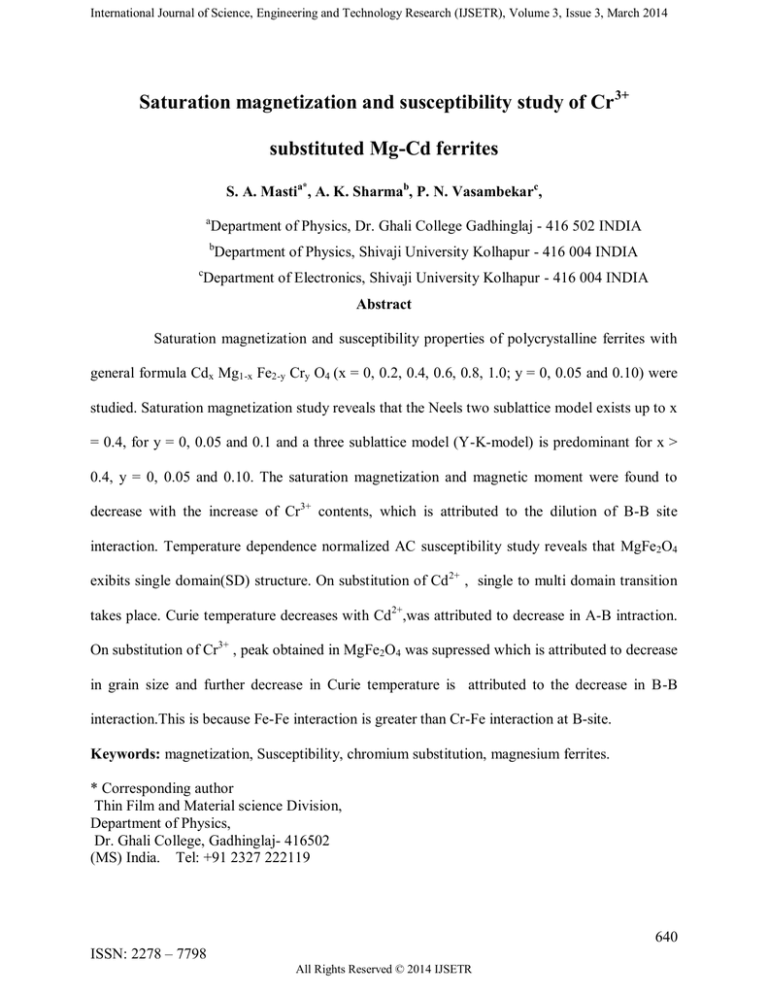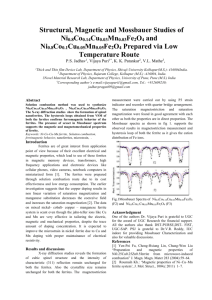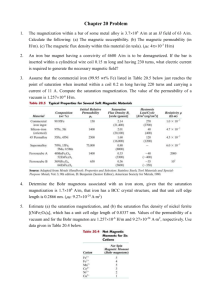
International Journal of Science, Engineering and Technology Research (IJSETR), Volume 3, Issue 3, March 2014
Saturation magnetization and susceptibility study of Cr 3+
substituted Mg-Cd ferrites
S. A. Mastia*, A. K. Sharmab, P. N. Vasambekarc,
a
Department of Physics, Dr. Ghali College Gadhinglaj - 416 502 INDIA
b
Department of Physics, Shivaji University Kolhapur - 416 004 INDIA
c
Department of Electronics, Shivaji University Kolhapur - 416 004 INDIA
Abstract
Saturation magnetization and susceptibility properties of polycrystalline ferrites with
general formula Cdx Mg1-x Fe2-y Cry O4 (x = 0, 0.2, 0.4, 0.6, 0.8, 1.0; y = 0, 0.05 and 0.10) were
studied. Saturation magnetization study reveals that the Neels two sublattice model exists up to x
= 0.4, for y = 0, 0.05 and 0.1 and a three sublattice model (Y-K-model) is predominant for x >
0.4, y = 0, 0.05 and 0.10. The saturation magnetization and magnetic moment were found to
decrease with the increase of Cr3+ contents, which is attributed to the dilution of B-B site
interaction. Temperature dependence normalized AC susceptibility study reveals that MgFe2O4
exibits single domain(SD) structure. On substitution of Cd 2+ , single to multi domain transition
takes place. Curie temperature decreases with Cd2+,was attributed to decrease in A-B intraction.
On substitution of Cr3+ , peak obtained in MgFe2O4 was supressed which is attributed to decrease
in grain size and further decrease in Curie temperature is attributed to the decrease in B-B
interaction.This is because Fe-Fe interaction is greater than Cr-Fe interaction at B-site.
Keywords: magnetization, Susceptibility, chromium substitution, magnesium ferrites.
* Corresponding author
Thin Film and Material science Division,
Department of Physics,
Dr. Ghali College, Gadhinglaj- 416502
(MS) India. Tel: +91 2327 222119
640
ISSN: 2278 – 7798
All Rights Reserved © 2014 IJSETR
International Journal of Science, Engineering and Technology Research (IJSETR), Volume 3, Issue 3, March 2014
1.
Introduction
Magnetization in spinel ferrites is due to the interaction between A-sites and B-sites.
Square loops with large Mr / Ms ratio are the prime requirement in recording and memory cores
[1]. The magnetic properties of mixed ferrites Mg-Zn [2], Mg-Cd [3] Mg-Mn [4] and Mg-Cu-Zn
[5] have been already studied. Trivalent substitution of Nd 3+ ions causes a decrease in the
magnetic moment of Mg-Zn ferrites [2]. Structural and magnetic studies of magnesium doped
ferrites have also been made by Widatallah et al [6]. Other researchers have also investigated the
effect of Cr3+ in different ferrite system [7]-[8]. The substitution of Mg2+ ions in Co-Cr ferrite
yields a decrease of the saturation magnetization.
Soft ferrites
consists of
Multimomain (MD), single domain(SD) and
superparamagnetic(SP) particle, which mainly depends on substituation [9]. These domain states
can be distingushed by the technique of low field AC sussceptibility [10]. The MD particles
have domain walls [11] and magnetic changes takes place due to domain wall(DW) motion. As
particle size decreases, formation of domain walls becomes energitcally unfavorable, then it is
said to be single domain (SD) particle. In these mañgnetic changes do not takes place through
DW motion but require the rotation of spins resulting in larger coersivity. As the particle size
further decreases, spins are affected by thermal fluctuations and the system becomes SP particle.
SP particle nature reduces magnetic character of the material. Cd 2+ substitution is interesting
substitutioin
in the spinels [12]. Addition of Cr 3+ in NiFe2O4 the domain structure changes
from MD to SD [13]. Substitued mixed Cu-Cd ferrites exhibit mixture of SD and MD partices
[14].
641
ISSN: 2278 – 7798
All Rights Reserved © 2014 IJSETR
International Journal of Science, Engineering and Technology Research (IJSETR), Volume 3, Issue 3, March 2014
2 Experimental
Spinel ferrites with general formula Cd x Mg1-x Fe2-y Cry O4 (x = 0, 0.2, 0.4, 0.6, 0.8,
1.0; y = 0, 0.05 and 0.10) were prepared by standard ceramic method. The oxides in their weight
proportion were mixed thoroughly and wet milled using acetone. The mixed powder was presintered at 7000C for 12 h and sintered at 10500C for 24 h. Sintered powder was again wet
milled using acetone and then pellets of 1cm in diameter were prepared by using hydraulic press,
applying pressure of 7 tons/cm2. The pellets were finally sintered at 10500C for 24 h. The furnace
was slowly cooled.
The powder of each composition under investigation was characterized by X-ray
diffraction using powder diffractometer PW 3710. CuK radiations of wavelength =1.54 A0
were employed.
The saturation magnetization of pelletized samples were studied at room temperature
using an AC current electromagnet type-high field hysteresis loop tracer
3 Results and Discussion
3.1 Characterization
A typical X-ray diffractogram is presented in Fig. 1 corresponding to the sample x = 0.6
and y = 0. From the X-ray diffraction study, it is seen that all the compositions have face
centered cubic spinel structure. The lattice constant plotted against Cd 2+ content is presented in
Figure 2. The lattice constant was found to increase with the increase of Cd 2+ content and
decreases with the increase of Cr3+. The X-ray density was also found to increase with Cd2+ and
decrease with Cr3+content. These changes are attributed to the differences in the ionic radii of
Fe2+(0.67A0), Cd2+(0.99A0), Cr3+(0.63A0).
642
ISSN: 2278 – 7798
All Rights Reserved © 2014 IJSETR
International Journal of Science, Engineering and Technology Research (IJSETR), Volume 3, Issue 3, March 2014
3.2 Magnetization
The magnetic parameters like saturation magnetization (Ms), magnetic moment [n] were
calculated and presented in Fig. 4 and Fig. 5. From these figures it is seen that Ms and n
increase with the increase of Cd2+ contents up to x = 0.4, for y = 0, 0.05 and 0.10. The substituted
Cd2+ ion invariably occupies A-site and displaces the proportional amount of Fe3+ ions from Asite to B-site. The net magnetization is resulting from the magnetization at A-sites and B-sites;
hence as the amount of non-magnetic Cd2+ ion increases on A-sites, the magnetization at A-site
decreases. This results in an increase of the net magnetization.
The increase in magnetization should be linear with Cd2+ content but it is practically true
up to x = 0.4 and deviates thereafter. This is because of canted spins at B-site, this suggest that
Neel’s two sublattice model is applicable up to x = 0.4 and thereafter Yafet-Kittle model is
applicable. The composition with x = 0.8 and 1.0 have no magnetization suggesting that they are
of paramagnetic nature at and above room temperature.
If a small amount of Cr3+ ions substitute Fe3+ ions, then Ms and n are found to decrease.
The substituting Cr3+ ions enter into B-sites [13], therefore the magnetization on B-site
decreases. This is because the magnetic moment of Cr 3+ is 3 B and that of Fe3+ is 5 B. This
results in the dilution of the magnetization on B-sites causing a reduction in Ms and n.
3.3 Normalized susceptiblity
The typical plots of normalized susceptiblity (χ/ χRT) verses temperature with y =0.05 is
presented in the Figure 6. From the study it can be seen that for magnesium ferrite, the
susceptibility slowly increases and reaches peak value with temperature and susddenly drops to
zero. The sudden drop of χ/ χRT curve shows the formation of single phase cubic spinel [15].The
643
ISSN: 2278 – 7798
All Rights Reserved © 2014 IJSETR
International Journal of Science, Engineering and Technology Research (IJSETR), Volume 3, Issue 3, March 2014
incresase
in
sussceptibility
with
peak
values
suggests
there
is
existance
of
multidomain(MD)particles in the material [16]. The peak is found to suppresed with substitution
of Cr3+ in MgFe2O4. The values of Curie tempratures obtained from the study of susceptebility is
plotted against Cd2+ and is presented in Figure 7. Curie temparature (Tc) decreases with Cr 3+
content. For the composition x=0.2; y=0, 0.05 and 0.1, susceptiblity is found to be independent
on temperature upto Tc and after Tc it suddenly drops to zero. Such nature of curve indicates
that the presence of SD particles in the materials [17]. Joshi et al [18] also reported similar
behaviour in Mg-Zn ferrite system. The compositions with x=0.4 and x=0.6 for y=0, 0.05 and
0.1 shows exponential decrease in
susceptibility indicating SD to SP transition.
The
composition with x=0.8 and x=1 y=0 , 0.05 and 0.1 shows paramagnetic behaviour at and above
room temperature. On substitutiion of Cd2+ in MgFe2O4 Curie temperature found to decrease.
This is because substituted Cd2+ ion invariably occupies tetrahedal (A) site, resulting into
decrease in A-B intereaction [19]. The composition with x= 0.8 and 1.00 shows paramagnetic
behaviour at room temparature, their Curie temperature lies below room tempetature.
Substitution of Cr3+ ion, Curie temperature of each composition is found to decrease. This is
attrbuted to dilution of B-B interaction[19]. On substitution Cr3+ ion occupies B-site replacing
equivalent Fe3+ ions and so also decrease in magnetization at B-site.
4. Conclusions
Magnetic parameters like Ms and n were found to increase with the increase of Cd2+
contents up to x = 0.4, for y = 0, 0.05 and 0.10 and deviates thereafter. this suggest that Neel’s
two sublattice model is applicable up to x = 0.4 and thereafter Yafet-Kittle model is applicable.
Temperature dependent normalized susceptibility measurements reveals that MgFe 2O4
exhibit MD particle and on substitution of Cd2+,domain structure changes from MD to SD and
644
ISSN: 2278 – 7798
All Rights Reserved © 2014 IJSETR
International Journal of Science, Engineering and Technology Research (IJSETR), Volume 3, Issue 3, March 2014
for higher concentration SD to SP. Curie temperature was found to decrease on substitution of
Cd2+, which is attributed to the dilution of A-B interaction. On substution of Cr3+, peak obtained
in the graph of normalized susceptibility of MgFe2O4 is suppresed may be attributed to the
decrease in grain size. Further decrease in Curie temperature in Mg-Cd ferrite system due to
substitution of Cr3+ is attributed to the dilution of B-B site.
References
[1]
C.T. Birajdara, T. Suresh, R.H. Kadam, K.M. Jadhav, “D.C. Electrical Resistivity and A.
C. “Susceptibility study of Mg-Cr spinel ferrites prepared by chemical synthesis
route”, Indian Streams Research journal, Vol. 2(9)63, October 2012.
[2]
S. S. Khot, N. S. Shinde, B. P. Ladgaonkar, B. B. Kale and S. C. Watawe, “Magnetic and
structural properties of Magnesium Zinc Ferrites synthesized at different temperature”
Advances in Applied Science Research, 2 (4) pp 460-471 , 2011.
[3] A. B. Gadkari, T.J. Shinde,P.N. Vasambekar “Structural and magnetic properties of
Nanocrystalline Mg–Cd ferrites prepared by oxalate co-precipitation method”,Journal of
Mater. Sci.: Mater. in Electronics Vol 21 (1) pp 96-103, January 2010.
[4] A. Lakshman, K.H. Rao, R.G. Mendiratta, “ Magnetic properties of In3 + and Cr3 +
Substituted Mg-Mn ferrites”, Journal of Mag. and Mag. Mater., Vol. 250 ,pp 92-97, (2002)
[5] J. Park, J. Kim and S. Cho, “Effect of Additives on the Magnetic Properties in Mg-Cu-Zn
Ferrite” J. PHYS. IV FRANCE , 7 pp 193-194, 1997.
[6] H . M . Widatallalh , C . Johnson , F . Berry , M . Pejaka .”Systhesis, Structural and mimetic
characterization of magnesium doped lithium ferrite of composition Li0.5 Fe2.5O4 ,“
Solid
645
ISSN: 2278 – 7798
All Rights Reserved © 2014 IJSETR
International Journal of Science, Engineering and Technology Research (IJSETR), Volume 3, Issue 3, March 2014
State Comun. 120 (4) pp 171-175, 2001.
[7] P . N . Vasambekar , R . G . Kulkarni , A . S . Vaingankar ,” Cation distribution and
susceptibility study of Cd-Co and Cr3+ ferrites” J . Mag . and .Mag .Mater ,Vol. 186 pp
333=341, 1998 .
[8] U .V . Chhaya , R . G . Kulkarni , “Metal-insulator type transition in aluminium and
chromium co-substituted nickel ferrites” Mater . Letters , Vol. 39 (2) pp 91-96 April 1999.
[9] G.B. Kadam, S.B. Shelke and K.M. Jadhav “Effect of Zinc on A. C. Susceptibility and D.
C. “Resistivity of Ni1-x Znx Fe2-yEuyO4” Journal of Electronic and Electrical Engineering,
Vol. 1, Issue 1, PP-03-11, 2010.
[10] A. Wiechec, R. Zach, Z. Kakol, Z. Tarnawski,, A. Koz"owski, J.M. Honig “Magnetic
susceptibility studies of single-crystalline zinc ferrites under pressure”, Physica B 359–
361 pp 1342–1344,2005.
[11] Murthy V.R.K. , Chitra S. And Reddy K.V.S., Indian J.Pure and Appl. Phy, 16(1978)79.
[12] A Y Lipare, P N Vasambekar and A S Vaingankar, “A.c. susceptibility study of CaCl2
doped copper– zinc ferrite system” Bull. Mater. Sci., Vol. 26, No. 5, pp. 493–497 August
2003.
[13] R. M. More, T.J. Shinde, N.D. Choudhari,P.N. Vasambekar “Effect of temperature on Xray, IR and magnetic properties of nickel ferrite prepared by oxalate co-precipitation
method” J. Mater. Sci. Volume 16,pp 721-724 2005.
[14] R.G. Kulkarni, R.V. Upadhay “Magnetic properties of Cu-Cd ferrite investigated by
Mössbauer spectroscopy” Journal Mater. Sci. Vol. 19,(5),pp1622-1628,May 1984.
[15] A.M Sankpal, S.S Suryavanshi, S.V Kakatkar, G.G Tengshe, R.S Patil, N.D Chaudhari, S.R
Sawant., “Magnetization studies on aluminium and chromium substituted Ni-Zn ferrites”,
646
ISSN: 2278 – 7798
All Rights Reserved © 2014 IJSETR
International Journal of Science, Engineering and Technology Research (IJSETR), Volume 3, Issue 3, March 2014
J. Mag. Mag. Mater.,Vol 186pp 349-356,July 1998.
[16] S. Basu, M. Pal, D. Chakravorty, “Magnetic properties of hydrothermally synthesized
BiFeO3 nanoparticles”, J. Mag. Mag Mater., Vol. 320 (24) pp 3347-33349, December
2008.
[17] G. Kumar, J. Chand, S. Verma and M Singh “Mixed Mg–Mn ferrites for high frequency
applications processed by citrate precursor technique” J. Phys. D: Appl. Phys. 42 pp 1-6,
2009.
[18] Feng Wang, Wei-Wei Huang, Shan-Yu Li, A-Qiang Lian, Xiao-Ting Zhang, Wei Cao,
“The magnetic properties of FexZn1-xO4 synthesized via the solid state reaction route:
Experiment and theory”, J. Mag. Mag Mater., Vol. 340, pp 5-9, August 2013
[19] P.A Mariño-Castellanos, J Anglada-Rivera, A Cruz-Fuentes, R Lora-Serrano “Magnetic
and microstructural properties of the Ti4+ doped Barium hexaferrites”, J. Mag. Mag
Mater.,Vol 280, (2–3), pp 214-220, September 2004.
647
ISSN: 2278 – 7798
All Rights Reserved © 2014 IJSETR
International Journal of Science, Engineering and Technology Research (IJSETR), Volume 3, Issue 3, March 2014
648
ISSN: 2278 – 7798
All Rights Reserved © 2014 IJSETR
International Journal of Science, Engineering and Technology Research (IJSETR), Volume 3, Issue 3, March 2014
649
ISSN: 2278 – 7798
All Rights Reserved © 2014 IJSETR
International Journal of Science, Engineering and Technology Research (IJSETR), Volume 3, Issue 3, March 2014
650
ISSN: 2278 – 7798
All Rights Reserved © 2014 IJSETR
International Journal of Science, Engineering and Technology Research (IJSETR), Volume 3, Issue 3, March 2014
651
ISSN: 2278 – 7798
All Rights Reserved © 2014 IJSETR






